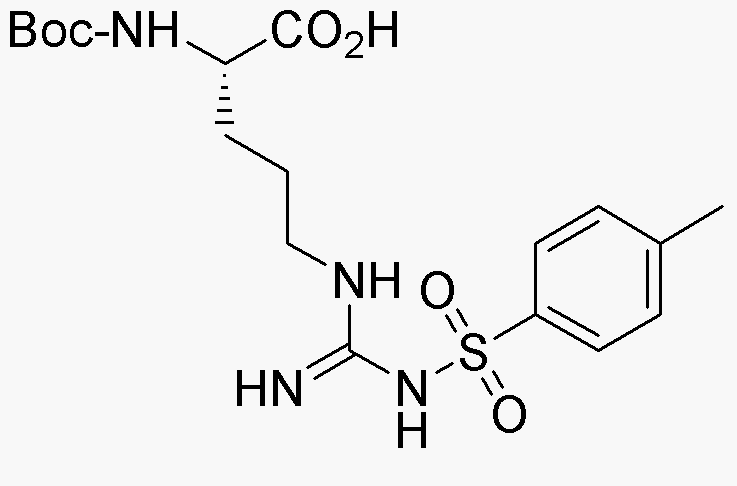Na-Boc-Nw-4-toluenesulfonyl-L-arginine is widely utilized in research focused on:
- Peptide Synthesis: This compound serves as a protecting group in the synthesis of peptides, allowing for selective reactions without interference from other functional groups. This is particularly beneficial in the pharmaceutical industry for creating complex peptide-based drugs.
- Bioconjugation: It is used in bioconjugation processes, where biomolecules are linked to other molecules, enhancing the development of targeted drug delivery systems. This application is crucial in the field of biotechnology and personalized medicine.
- Enzyme Inhibition Studies: Researchers utilize this compound to study enzyme inhibition mechanisms, providing insights into metabolic pathways and potential therapeutic targets, which is vital for drug discovery.
- Diagnostic Reagents: The compound can be employed as a reagent in diagnostic tests, particularly in assays that require specific binding interactions, thus improving the accuracy of medical diagnostics.
- Research on Protein Interactions: It aids in the investigation of protein-protein interactions, helping scientists understand cellular processes and disease mechanisms, which is essential for developing new therapeutic strategies.
General Information
Properties
Safety and Regulations
Applications
Na-Boc-Nw-4-toluenesulfonyl-L-arginine is widely utilized in research focused on:
- Peptide Synthesis: This compound serves as a protecting group in the synthesis of peptides, allowing for selective reactions without interference from other functional groups. This is particularly beneficial in the pharmaceutical industry for creating complex peptide-based drugs.
- Bioconjugation: It is used in bioconjugation processes, where biomolecules are linked to other molecules, enhancing the development of targeted drug delivery systems. This application is crucial in the field of biotechnology and personalized medicine.
- Enzyme Inhibition Studies: Researchers utilize this compound to study enzyme inhibition mechanisms, providing insights into metabolic pathways and potential therapeutic targets, which is vital for drug discovery.
- Diagnostic Reagents: The compound can be employed as a reagent in diagnostic tests, particularly in assays that require specific binding interactions, thus improving the accuracy of medical diagnostics.
- Research on Protein Interactions: It aids in the investigation of protein-protein interactions, helping scientists understand cellular processes and disease mechanisms, which is essential for developing new therapeutic strategies.
Documents
Safety Data Sheets (SDS)
The SDS provides comprehensive safety information on handling, storage, and disposal of the product.
Product Specification (PS)
The PS provides a comprehensive breakdown of the product’s properties, including chemical composition, physical state, purity, and storage requirements. It also details acceptable quality ranges and the product's intended applications.
Certificates of Analysis (COA)
Search for Certificates of Analysis (COA) by entering the products Lot Number. Lot and Batch Numbers can be found on a product’s label following the words ‘Lot’ or ‘Batch’.
*Catalog Number
*Lot Number
Certificates Of Origin (COO)
This COO confirms the country where the product was manufactured, and also details the materials and components used in it and whether it is derived from natural, synthetic, or other specific sources. This certificate may be required for customs, trade, and regulatory compliance.
*Catalog Number
*Lot Number
Safety Data Sheets (SDS)
The SDS provides comprehensive safety information on handling, storage, and disposal of the product.
DownloadProduct Specification (PS)
The PS provides a comprehensive breakdown of the product’s properties, including chemical composition, physical state, purity, and storage requirements. It also details acceptable quality ranges and the product's intended applications.
DownloadCertificates of Analysis (COA)
Search for Certificates of Analysis (COA) by entering the products Lot Number. Lot and Batch Numbers can be found on a product’s label following the words ‘Lot’ or ‘Batch’.
*Catalog Number
*Lot Number
Certificates Of Origin (COO)
This COO confirms the country where the product was manufactured, and also details the materials and components used in it and whether it is derived from natural, synthetic, or other specific sources. This certificate may be required for customs, trade, and regulatory compliance.


